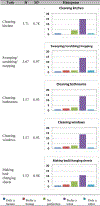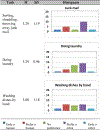The Domesticated Robot: Design Guidelines for Assisting Older Adults to Age in Place
- PMID: 31240279
- PMCID: PMC6592031
- DOI: 10.1145/2157689.2157806
The Domesticated Robot: Design Guidelines for Assisting Older Adults to Age in Place
Abstract
Many older adults wish to remain in their own homes as they age [16]. However, challenges in performing home upkeep tasks threaten an older adult's ability to age in place. Even healthy independently living older adults experience challenges in maintaining their home [13]. Challenges with home tasks can be compensated through technology, such as home robots. However, for home robots to be adopted by older adult users, they must be designed to meet older adults' needs for assistance and the older users must be amenable to robot assistance for those needs. We conducted a needs assessment to (1) assess older adults' openness to assistance from robots; and (2) understand older adults' opinions about using an assistive robot to help around the home. We administered questionnaires and conducted structured group interviews with 21 independently living older adults (ages 65-93). The questionnaire data suggest that older adults prefer robot assistance for cleaning and fetching/organizing tasks overall. However their assistance preferences discriminated between tasks. The interview data provided insight as to why they hold such preferences. Older adults reported benefits of robot assistance (e.g., the robot compensating for limitations, saving them time and effort, completing undesirable tasks, and performing tasks at a high level of performance). Participants also reported concerns such as the robot damaging the environment, being unreliable at or incapable of doing a task, doing tasks the older adult would rather do, or taking up too much space/storage. These data, along with specific comments from participant interviews, provide the basis for preliminary recommendations for designing mobile manipulator robots to support aging in place.
Keywords: Aging; Aging in Place; Assistive Robotics; Chores; Design; Design Guidelines; Experimentation; Home; Home Environment; Human Factors; Measurement; Mobile Manipulation; Needs Assessment; Older Adults; Service Robotics.
Figures
References
-
- AARP. (2005, April). Beyond 50.05 survey. Retrieved February 13, 2009, from http://assets.aarp.org/rgcenter/il/beyond_50_05_survey.pdf
-
- Baltes PB, and Baltes MM 1990. Psychological perspectives on successful aging: The model of selective optimization with compensation In Baltes P and Baltes M (Eds.), Successful aging: Perspectives from the Behavioral Sciences, 1–34. New York: Cambridge University Press.
-
- Broadbent E, Stafford R, and MacDonald B 2009. Acceptance of Healthcare Robots for the Older Population: Review and Future Directions. International Journal of Social Robotics, 1, 4 (2009), 319–330. DOI = 10.1007/s12369-009-0030-6. - DOI
-
- Bugmann G, and Copleston S 2011. What Can a Personal Robot Do for You? In Groβ R, Alboul L, Melhuish C, Witkowski M, Prescott T & Penders J (Eds.), Towards Autonomous Robotic Systems, 6856, 360–371. Berlin/Heidelberg: Springer.
Grants and funding
LinkOut - more resources
Full Text Sources




